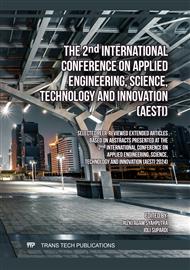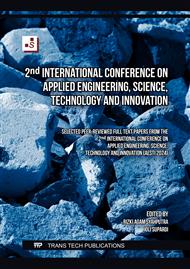[1]
J. Davidovits, "Geopolymer Chemistry And Applications. Geopolymer Institute," 2020.
Google Scholar
[2]
A. Hassan, M. Arif, And M. Shariq, "A Review Of Properties And Behaviour Of Reinforced Geopolymer Concrete Structural Elements-A Clean Technology Option For Sustainable Development," J. Clean. Prod., Vol. 245, P. 118762, 2020.
DOI: 10.1016/j.jclepro.2019.118762
Google Scholar
[3]
G. M. Zannerni, K. P. Fattah, And A. K. Al-Tamimi, "Ambient-Cured Geopolymer Concrete With Single Alkali Activator," Sustain. Mater. Technol., Vol. 23, P. E00131, 2020.
DOI: 10.1016/j.susmat.2019.e00131
Google Scholar
[4]
M. Verma And N. Dev, "Geopolymer Concrete: A Way Of Sustainable Construction," Int. J. Recent Res. Asp., Vol. 5, No. 1, Pp. 201–205, 2018.
Google Scholar
[5]
R. Firdous, D. Stephan, And J. N. Y. Djobo, "Natural Pozzolan Based Geopolymers: A Review On Mechanical, Microstructural And Durability Characteristics," Constr. Build. Mater., Vol. 190, Pp. 1251–1263, 2018.
DOI: 10.1016/j.conbuildmat.2018.09.191
Google Scholar
[6]
A. Muis, S. Bahri, And S. Sulaiman, "Pengaruh Penggunaan Fly Ash Dengan Volume Tinggi Dan Abu Sekam Padi Terhadap Kuat Lentur Beton Mutu Tinggi," In Prosiding Seminar Nasional Politeknik Negeri Lhokseumawe, 2021, Pp. 104–107.
DOI: 10.30811/teknologi.v21i2.2433
Google Scholar
[7]
J. Davidovits, "Geopolymer Chemistry And Applications. Geopolymer Institute," 2020.
Google Scholar
[8]
J. Davidovits, "Geopolymer Chemistry And Applications; Geopolymer Institute: Saint-Quentin, France, 2008," Search In.
Google Scholar
[9]
J. Davidovits And J. Orlinski, '99 Geopolymer International Conference Proceedings. Geopolymer Institute, 1999.
Google Scholar
[10]
J. B. Bhushan, "Geopolymer Concrete–A Review," Joseph Davidovits, Pp. 1633–1656, 1991.
Google Scholar
[11]
A. Pathak, "A Laboratory Scale Synthesis Of Geopolymer From Construction Wastes," 2018.
Google Scholar
[12]
B. Singh, G. Ishwarya, M. Gupta, And S. K. Bhattacharyya, "Geopolymer Concrete: A Review Of Some Recent Developments," Constr. Build. Mater., Vol. 85, Pp. 78–90, Jun. 2015.
DOI: 10.1016/J.Conbuildmat.2015.03.036
Google Scholar
[13]
M. Grant Norton And J. L. Provis, "1000 At 1000: Geopolymer Technology—The Current State Of The Art," J. Mater. Sci., Vol. 55, No. 28, Pp. 13487–13489, Oct. 2020.
DOI: 10.1007/S10853-020-04990-Z
Google Scholar
[14]
J. Davidovits, "Geopolymers: Inorganic Polymeric New Materials," J. Therm. Anal., Vol. 37, No. 8, Pp. 1633–1656, Aug. 1991.
DOI: 10.1007/Bf01912193
Google Scholar
[15]
Q. Meng, H. Wang, W. Wang, W. Shen, And C. Zhu, "Editorial: Microscopic Structure Effect On The Macroscopic Property Of Geomaterials," Front. Phys., Vol. 10, P. 1046888, Oct. 2022.
DOI: 10.3389/Fphy.2022.1046888
Google Scholar
[16]
M. Rafieizonooz, E. Khankhaje, And S. Rezania, "Assessment Of Environmental And Chemical Properties Of Coal Ashes Including Fly Ash And Bottom Ash, And Coal Ash Concrete," J. Build. Eng., Vol. 49, P. 104040, 2022.
DOI: 10.1016/j.jobe.2022.104040
Google Scholar
[17]
M. Ahmaruzzaman, "A Review On The Utilization Of Fly Ash," Prog. Energy Combust. Sci., Vol. 36, No. 3, Pp. 327–363, Jun. 2010.
DOI: 10.1016/J.Pecs.2009.11.003
Google Scholar
[18]
X. Y. Zhuang Et Al., "Fly Ash-Based Geopolymer: Clean Production, Properties And Applications," J. Clean. Prod., Vol. 125, Pp. 253–267, Jul. 2016, Doi: 10.1016/J.Jclepro. 2016.03.019.
DOI: 10.1016/j.jclepro.2016.03.019
Google Scholar
[19]
C09 Committee, "Specification For Coal Fly Ash And Raw Or Calcined Natural Pozzolan For Use In Concrete," Astm International.
DOI: 10.1520/C0618-12
Google Scholar
[20]
P. Bankowski, L. Zou, And R. Hodges, "Reduction Of Metal Leaching In Brown Coal Fly Ash Using Geopolymers," J. Hazard. Mater., Vol. 114, No. 1–3, Pp. 59–67, Oct. 2004.
DOI: 10.1016/J.Jhazmat.2004.06.034
Google Scholar
[21]
S. K. Antiohos And S. Tsimas, "A Novel Way To Upgrade The Coarse Part Of A High Calcium Fly Ash For Reuse Into Cement Systems," Waste Manag., Vol. 27, No. 5, Pp. 675–683, Jan. 2007.
DOI: 10.1016/J.Wasman.2006.03.016
Google Scholar
[22]
Y. Sandya And S. Musalamah, "Penggunaan Abu Sekam Padi Sebagai Pengganti Semen Pada Beton Geopolimer," Educ Build J Pendidik Tek Bangunan Dan Sipil, Vol. 5, No. 2, Pp. 59–63, 2019.
DOI: 10.20961/jrrs.v4i2.42978
Google Scholar
[23]
A. W. Iryani And O. Yanti, "Analisis Kuat Tekan Beton Geopolymer Menggunakan Kombinasi Fly Ash Dan Abu Sekam Padi," Politeknik Negeri Sriwijaya, 2021.
DOI: 10.33558/bentang.v9i2.2859
Google Scholar
[24]
M. Sulistyani And N. Huda, "Perbandingan Metode Transmisi Dan Reflektansi Pada Pengukuran Polistirena Menggunakan Instrumentasi Spektroskopi Fourier Transform Infra Red," Indones. J. Chem. Sci., Vol. 7, No. 2, Pp. 195–198, 2018.
DOI: 10.25077/temapela.1.2.39-43.2018
Google Scholar
[25]
H. A. Syarif, "Analisis Gugus Fungsi Pada Senyawa Mikrostruktur Mortar Geopolimer Abu Sawit Dengan Penambahan Portland Composite Cement (Pcc)," Aptek, Pp. 104–110, 2023.
DOI: 10.30606/aptek.v14i2.1429
Google Scholar
[26]
S. Kamara, E. H. Foday Jr, And W. Wang, "A Study Of The Characterization Of Purified Fly Ash From Xi'an Linyuan Silica Limited," Am. J. Chem. Pharm., Vol. 2, No. 2, Pp. 41–52, Jul. 2023.
DOI: 10.54536/Ajcp.V2i2.1608
Google Scholar
[27]
A. Sutama And N. Oemiati, "Studi Mikrostruktur Beton Ringan Geopolimer Dengan Scanning Electron Microscope (Sem) Dan X-Ray Diffraction (Xrd)," J. Deform., Vol. 7, No. 2, Pp. 145–160, 2022.
Google Scholar
[28]
K. Y. Putri, I. Iskandar, R. Ruhana, M. Miswar, And A. Fauzi, "Pengaruh Penggunaan Lumpur Sidoarjo Sebagai Substitusi Material Fly Ash Pada Geopolimer," In Prosiding Seminar Nasional Politeknik Negeri Lhokseumawe, 2019, P. 304.
Google Scholar
[29]
N. M. Sutan, I. Yakub, And S. Hamdan, "Physicochemical Characterization Of Polymer Composite Cement Systems," Presented At The Hpsm/Opti 2014, Ostend, Belgium, Jun. 2014, Pp. 103–111.
DOI: 10.2495/Hpsm140101
Google Scholar



